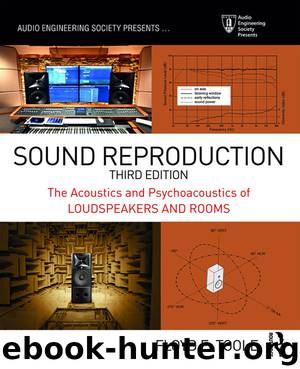Sound Reproduction (Audio Engineering Society Presents) by Floyd E. Toole

Author:Floyd E. Toole [Toole, Floyd E.]
Language: eng
Format: mobi, epub
ISBN: 9781138921375
Publisher: Taylor and Francis
Published: 2017-07-28T04:00:00+00:00
The listening areas are different from that used in the preceding examples, so the MSV numbers will not be directly comparable. Given that we have already seen that moving listeners away from null lines is advantageous, it is clear that some of the large seating configurations in the new study will yield higher MSVs than the smaller, more centrally located areas. Those that avoid the null lines would be expected to show improvements over those that do not.
Figure 8.18 shows mean MSV values for these configurations. It can be seen that the small, centrally located listening areas SC and SR are advantageous, along with the Large Rear modified (LRm) arrangement that avoids the second-order null lines. This shows up very clearly in the averaged values along the bottom of the table. If one were to choose the best of the listener arrangements, SC, SR and LRm, the averages along the right side of the table indicate an advantage for the 4M loudspeaker arrangement, but the spread among them is small compared to other numbers in the table.
Figure 8.19 answers the second important question: now that one can identify listener and loudspeaker arrangements that yield superior seat-to-seat consistency, which listener and loudspeaker arrangement(s) generate the highest sound levels from a given set of subwoofers? The MOL metric (Mean Output Level) is a metric giving a relative low frequency efficiency for each configuration (averaged SPL over all seats from 20–40 Hz, normalized to account for the number of subwoofers used).
The answer is the same for the listener arrangements, but with respect to loudspeaker arrangements the outstanding winner for efficiency is 4C—four subwoofers, one in each corner. Not far behind are the FBQ and LRQ subwoofer configurations. The mid-wall subwoofer arrangements, which did well in terms of MSV (Figure 8.18), do so at the expense of higher power requirements and/or larger subwoofers.
Figure 8.18Mean MSV values (dB2) for the configurations shown in Figure 8.17, listener arrangement horizontally and loudspeaker arrangements vertically. In this table, lower values indicate smaller seat-to-seat variations. The best values for each seating arrangement are in bold. The basic table is from Welti (2012), table 2. The additional numbers added outside the table boundaries by the author are, horizontally, the averages of listener-configuration scores, ignoring the poorly performing reference condition: FLC. The vertical numbers on the right are the average loudspeaker-configuration scores for the best listener arrangements SC, SR and LRm. Asterisks indicate the top three scores.
Download
Sound Reproduction (Audio Engineering Society Presents) by Floyd E. Toole.epub
This site does not store any files on its server. We only index and link to content provided by other sites. Please contact the content providers to delete copyright contents if any and email us, we'll remove relevant links or contents immediately.
Kotlin in Action by Dmitry Jemerov(17185)
Grails in Action by Glen Smith Peter Ledbrook(15390)
Sass and Compass in Action by Wynn Netherland Nathan Weizenbaum Chris Eppstein Brandon Mathis(13266)
Azure Containers Explained by Wesley Haakman & Richard Hooper(7499)
Configuring Windows Server Hybrid Advanced Services Exam Ref AZ-801 by Chris Gill(7497)
Running Windows Containers on AWS by Marcio Morales(7054)
Microsoft 365 Identity and Services Exam Guide MS-100 by Aaron Guilmette(5436)
Microsoft Cybersecurity Architect Exam Ref SC-100 by Dwayne Natwick(5273)
Combating Crime on the Dark Web by Nearchos Nearchou(5018)
The Ruby Workshop by Akshat Paul Peter Philips Dániel Szabó and Cheyne Wallace(4701)
Management Strategies for the Cloud Revolution: How Cloud Computing Is Transforming Business and Why You Can't Afford to Be Left Behind by Charles Babcock(4550)
Python for Security and Networking - Third Edition by José Manuel Ortega(4274)
The Age of Surveillance Capitalism by Shoshana Zuboff(4252)
Learn Wireshark by Lisa Bock(4176)
Learn Windows PowerShell in a Month of Lunches by Don Jones(4069)
The Ultimate Docker Container Book by Schenker Gabriel N.;(3920)
Ember.js in Action by Joachim Haagen Skeie(3661)
DevSecOps in Practice with VMware Tanzu by Parth Pandit & Robert Hardt(3612)
Windows Ransomware Detection and Protection by Marius Sandbu(3579)
